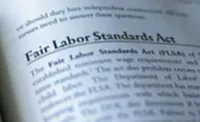DOL Changes Definition of Independent Contractors

The Fair Labor Standards Act (FLSA) was passed more than 80 years ago, and since then, the United States Department of Labor has struggled to define the term “independent contractor.” The Supreme Court of the United States has not spoken on the issue in over a half century, with both workers and employers having to parse through dense case law for guidance on the classification of laborers as employees or independent contractors.
On Sept. 22, 2020, the Department of Labor released a proposed rule change, which seeks to clarify the distinction between employee and independent contractor. The proposed change is currently open for public comment, and once finalized, will “codify a simple, clear approach that can be applied consistently nationwide.”
The renewed focus on the classification of workers as employees or independent contractors has grown from a rise in the “gig economy.” That is, companies like Uber, Grubhub, and Lyft have millions of Americans working for them every year who are currently classified as independent contractors. This, of course, carries with it a significant benefit in the arenas of liability and taxation for these emerging tech giants.
Though the proposed rule change was made with large, multinational companies in mind, the impact will be wide and sweeping. An area of particular concern is in the construction industry — the “Economic Realities Test” will have a significant role in determining whether workers on construction sites are classified as employees or independent (sub-) contractors. The change will affect OSHA, wage and hour determinations and distributions, and potentially even immigration.
The proposed rule changed the previous seven-factor test and instead, requires the consideration of two primary factors and an additional three factors for guidance. The first primary factor for consideration is the nature and degree of a worker’s control over the work that needs to be performed. This factor will look at whether the worker has the autonomy to make decisions on how to proceed with tasks, or if, on the other hand, a prime contractor is directing the worker's every move.
The second primary factor for consideration is the opportunity for profit or loss by the worker on the job. Put simply, this factor asks whether there is a monetary incentive for the worker to complete the job efficiently — the ability to gain or lose depending on the success of their work. The exercise of personal initiative including managerial skill and business acumen and the management of investments or capital expenditures as it relates to the job will also weigh in a determination under the second factor.
In addition to the two core factors, the proposed rule change includes three factors that are available for consideration. The first additional factor is the amount of specialized skill or training required to complete the work. For example, the requirement of a specialty license as opposed to work that is best characterized as general labor will weigh in the direction of classification as an independent contractor. The second additional factor is the degree of permanence in the relationship between the prime and the worker. If, for instance, the worker works exclusively for the prime and has done so for a significant period of time, it will be more likely that the worker will be classified as an employee. Finally, the third additional factor will ask whether the work the subcontractor is doing is an integrated unit of production. This factor considers whether the worker is performing a task that would usually be performed by an employee of the prime — if so, it would lend itself toward a determination of employee status.
Taking these factors into consideration will allow contractors to properly classify their workers as either employees or independent (sub-) contractors and avoid the possible consequences of misclassification. Consideration of the proposed rule change leads to two major recommendations: first, make sure to have a strong subcontractor. The presence of a subcontract is not the end-all-be-all in determining whether a worker is classified as an employee or a subcontractor. Instead, the “economic reality” of the situation will be determinative of their proper classification. Second, make sure that the prime and subcontractor maintain their independence. The prime and sub should both have independent marketing and advertising, wear their own safety gear, and not maintain an exclusive relationship with one another.
Disclaimer: The information contained in this article is for general educational information only. This information does not constitute legal advice, is not intended to constitute legal advice, nor should it be relied upon as legal advice for your specific factual pattern or situation.
Looking for a reprint of this article?
From high-res PDFs to custom plaques, order your copy today!








